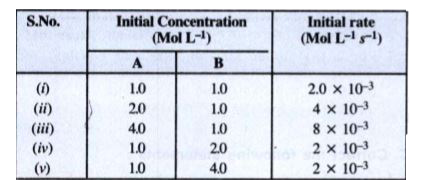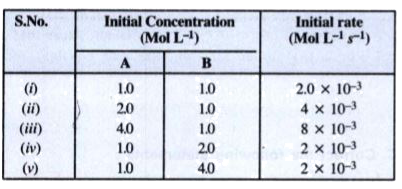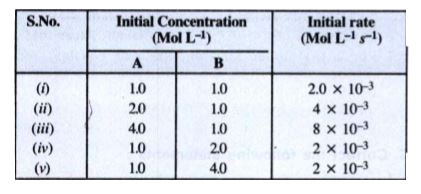In a reaction between A and B, the initial rate of reaction was measured for different initial concentrations of A and B as given below:

What is the order of reaction with respect to A and B ?
Let the order of the reaction with respect to A be x and with respect to B be y .
Therefore ,
Dividing equation (i) by (ii) , we obtain
Dividing equation (iii) by (ii) , we obtain
(Taking log on both sides )
=
= (approximately )
Hence, the order of the reaction with respect to A is and with respect to B is zero .
Topper's Solved these Questions
- CHEMICAL KINETICSBOOK - NCERT ENGLISHCHAPTER - CHEMICAL KINETICSEXERCISE - Exercise
1 Videos
- CHEMICAL KINETICSBOOK - NCERT ENGLISHCHAPTER - CHEMICAL KINETICSEXERCISE - SOLVED EXAMPLE
1 Videos
- BIOMOLECULESBOOK - NCERT ENGLISHCHAPTER - BIOMOLECULESEXERCISE - Exercise
33 Videos
- CHEMISTRY IN EVERYDAY LIFEBOOK - NCERT ENGLISHCHAPTER - CHEMISTRY IN EVERYDAY LIFEEXERCISE - Exercise
32 Videos
Similar Questions
Consider the reaction, A+B→C+D.
The initial rate for different initial concentrations of the reactants are given below :

Calculate the rate constant.
View SolutionConsider the reaction, A+B→C+D.
The initial rate for different initial concentrations of the reactants are given below :

What are the orders with respect to A and B ?
View SolutionConsider the reaction, A+B→C+D.
The initial rate for different initial concentrations of the reactants are given below :

What are the orders with respect to A and B ?
View SolutionConsider the reaction, A+B→C+D.
The initial rate for different initial concentrations of the reactants are given below :

What is the overall order ?
View SolutionConsider the reaction, A+B→C+D.
The initial rate for different initial concentrations of the reactants are given below :

What is the overall order ?
View SolutionConsider the reaction, A+B→C+D.
The initial rate for different initial concentrations of the reactants are given below :

What is the overall order ?
View SolutionFor the reaction A+B→C+D, the initial rate for different reactions and initial concentration of reactants are given below:

(i) What is the overall order of reaction ?
(ii) Write the rate law equation.
View SolutionThe half life for a given reaction was doubled as the initial concentration of a reactant was doubled. What is the order of reaction.
View SolutionConsider the reaction, A+B→C+D.
The initial rate for different initial concentrations of the reactants are given below :

Write the rate law equation.
View SolutionConsider the reaction, A+B→C+D.
The initial rate for different initial concentrations of the reactants are given below :

Write the rate law equation.
View Solution
